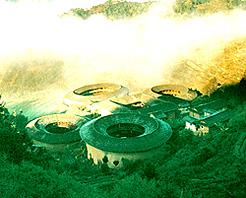1) earth building


土楼
1.
Combined with modern construction materials and equipment,the Chinese traditional dwelling earth buildings space and traffic organization are introduced in to remodel the residential district.
通过对其构造、使用空间的分析,充分利用原有结构,结合现代建筑材料、设备及符合日常居住需要的设计理念,并引用类设计理论,将中国土楼民居中空间、交通组织形式引入到小区的改造中来,在不破坏整体结构与外观的基础上,进行改建,使之适合现代生活的需要。
2.
The rammed-earth construction technology of Fujian earth building is a specific product resulting from the integration with the old Chinese raw soil construction technique and the local natural and social environment.
福建土楼夯土版建筑技术是古老的中国生土建筑工艺和当地自然、社会环境相结合而产生的一种特殊产物,文章详细介绍了它的历史传承、夯筑土墙的材料、作法、工具及建造土楼的全过程。
3.
Based on the first -hand information,the article introduces the history overall layout、individual building and detailed structure ol Tian-luokeng earth building.
本文以第一手的实测资料为背景,介绍了堪称土楼明珠的南靖县书洋乡上板寮村田螺坑土楼建筑群的历史沿革、总体布局、单体建筑、细部构造及提出初步分析结论。
2) earth buildings


土楼
1.
Laozi′s Idea of Correct Reason and Ecology of Earth Buildings in Fujian;


老子大道理念与福建土楼人居生态
2.
The Analyses of The Echoes of Hakka s Earth Buildings based on music anthropology;


从音乐人类学角度评析《土楼回响》
3.
The environmental value of earth buildings was excavated in this essay,which including the Fengshui in choosing the site,the space characteristics within the building,the landscape around the building and the culture meaning ; by comparing examples ,the importance of environmental value estimate in protecting and developing architecture heritages was emphasized .
文章从南靖土楼选址的风水格局、建筑的空间布局、景观环境的营造以及文化内涵的传承等四个方面深刻挖掘土楼的环境价值;通过实例比较,强调了在土楼保护和开发的过程中重视环境价值认知的重要性。
3) earth-building


土楼
1.
The development such to Earth-building tourism culture is dynamic, and it keeps continuous alternation.
土楼旅游文化其发展是动态的,不断发展变化的,是一个处于不断再生产的过程。
4) Hakka Earth Building


客家土楼
1.
As one of the rarities of Chinese ancient architectures, could Hakka Earth Buildings in Yongding, Fujian Province break away from the crisis? During the process of modern urbanization, could the special culture .
”作为中国古建筑瑰宝之一的福建永定客家土楼建筑:能否摆脱这种危机?在逐步现代化的城市发展步伐当中,客家土楼特色文化能否屹立不倒?在未来的城市中,土楼能否体现其特有的人文与历史价值并继续延续下去?其空间构成究竟具有什么样的特色魅力?带着诸多问题,本文试对福建永定客家土楼建筑空间进行了相关的实地考察与研究。
5) Hakka earth buildings in Chuxi


初溪土楼
补充资料:漳州土楼

漳州土楼
漳州土楼遍布于漳州市的南靖、华安、平和、诏安、云霄、漳浦等山区。它以造型奇异、风格独特而被誉为“神话般的山区建筑”。 土楼的前身是唐朝陈元光开漳时的兵营、城堡和山寨建筑,它是闽南地区在“外寇之出入,蟊贼之内讧”的特殊社会环境下的产物。漳州土楼以生土为主要材料,掺上石灰、细砂、糯米饭、红糖、竹片、木条等,经反复舂压、夯筑而成,一般高三至五层,一层为厨房,二层为仓库,三层以上为起居室,可居住200至700人,具有聚族而居、防盗、防震、防兽、防火、防潮、通风采光、冬暖夏凉等特点。 漳州土楼数量很多,共有800多座。历史最悠久的是华安县沙建镇的“齐云楼”,它是目前所发现的最古老的有确切纪年的土楼,建于明洪武四年(1371年);规模最大的土楼是直径达94.5米的诏安县宫陂乡“在田楼”,它有“超级土楼”之称;土楼造型多样,有圆方、椭圆、半月、交椅、雨伞、风车、八卦等形状,最为奇特的是南靖县书洋乡田螺坑的土楼,它是由一方一椭三圆五座土楼组合而成,气势磅礴,令人震撼。
说明:补充资料仅用于学习参考,请勿用于其它任何用途。